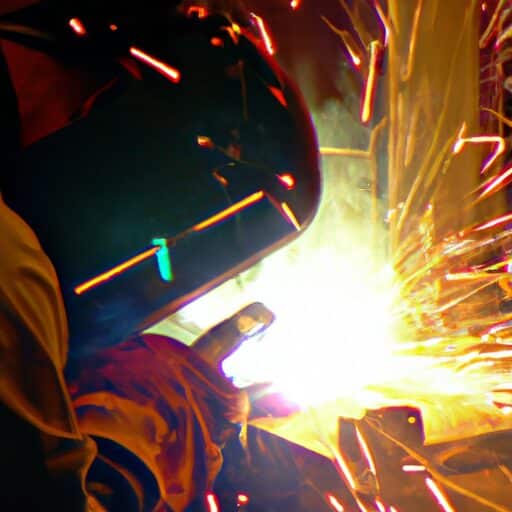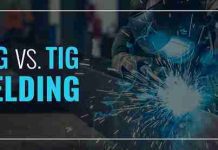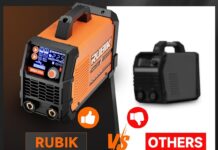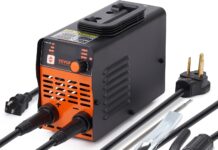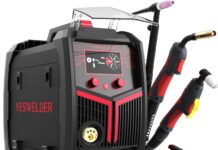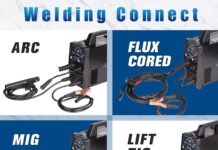Let us take you on a fascinating journey into the inner workings of a MIG welder. As we explore the intricate process of MIG welding, we’ll uncover the secrets behind this incredible machine. From the mesmerizing dance of electric arcs to the transformation of metal into solid bonds, we’ll reveal the mechanics that make a MIG welder an indispensable tool for welding enthusiasts and professionals alike. Get ready to witness the synergy between electricity, gas, and consumable wire as we unravel the mysteries of MIG welding.
Overview of MIG Welding
MIG welding, also known as Metal Inert Gas welding, is a popular welding technique that utilizes a continuous and consumable wire electrode to create an electric arc between the wire and the metal being welded. This process is widely used in both industrial and home settings due to its versatility, ease of use, and efficiency. In MIG welding, the wire electrode also serves as the filler material, eliminating the need for a separate filler rod. This article will provide an in-depth look at the components of a MIG welder and the core principles underlying this welding technique.
Definition of MIG Welding
MIG welding, as mentioned earlier, stands for Metal Inert Gas welding. The term “inert gas” refers to the shielding gas used in this process, which is typically a mixture of argon and carbon dioxide. This gas shields the weld pool, preventing it from reacting with the surrounding air, which can cause impurities and weaken the weld. MIG welding is a semi-automatic process, meaning that it requires the welder to control the movement of the welding torch while the wire feeder automatically feeds the wire into the weld pool.
Basic Components of a MIG Welder
A MIG welder consists of several essential components that work together to produce a successful weld. The main components include the power source, wire feeder, shielding gas system, and electrode wire. Understanding the role and function of each component is crucial in achieving high-quality welds consistently.
Core Principles of MIG Welding
MIG welding operates on several core principles that govern its efficiency and effectiveness. These principles include maintaining a stable arc length, proper voltage settings, control over heat output, and using correct welding techniques. By adhering to these principles, welders can produce strong, clean, and reliable welds.
Power Source
The power source is a critical component of a MIG welder, as it supplies the electrical energy required to create and maintain the arc. There are various types of power sources, including transformers and inverters, each with its advantages and limitations. The power source determines the welding output, such as the weld amperage and voltage, which can be adjusted to suit the specific requirements of the welding project.
Types of Power Sources
In MIG welding, there are two main types of power sources: constant current (CC) and constant voltage (CV). Constant current power sources provide a stable output current regardless of voltage fluctuations, making them ideal for welding thin materials. On the other hand, constant voltage power sources maintain a consistent voltage output, allowing for greater control over the weld pool and penetration. The choice of the power source depends on the welding application and the materials being welded.
Role of Power Source in MIG Welding
The power source plays a crucial role in MIG welding, as it determines the weld quality and characteristics. It provides the necessary electrical energy to generate the electric arc, which melts the electrode wire and the base metal, creating a pool of molten metal. The power source also allows for the adjustment of amperage and voltage, ensuring that the weld pool is adequately formed and fused with the base metal.
Wire Feeder
The wire feeder is responsible for supplying the consumable electrode wire to the welding torch at a controlled and consistent rate. This component ensures a continuous and uninterrupted flow of the electrode wire into the weld pool, facilitating a stable arc and precise control over the welding process.
Purpose of Wire Feeder
The wire feeder serves a vital purpose in MIG welding, as it eliminates the need for manual feeding of the wire into the welding torch. This automation not only increases efficiency but also allows the welder to focus on maintaining proper torch positioning and movement. The wire feeder ensures a consistent and accurate wire feed speed, which directly affects the deposition rate and the integrity of the weld.
Types of Wire Feeders
There are two main types of wire feeders used in MIG welding: push-pull feeders and push-only feeders. Push-pull feeders are commonly used for aluminum welding or when working with long distances between the power source and the welding torch. They provide both pushing and pulling forces to ensure smooth wire feeding. Push-only feeders, on the other hand, are designed for general welding applications, where the distance between the power source and the welding torch is relatively short.
Wire Feeding Mechanism
The wire feeder employs a motor-driven mechanism that pulls the wire from a spool and feeds it through the welding torch. The wire is guided by a series of rollers, which maintain consistent tension and prevent tangling or kinking. The wire feeding speed can be adjusted to control the deposition rate and allows for precise control over the amount of filler material added to the weld pool.
Shielding Gas
Shielding gas is a crucial element in MIG welding, as it serves to protect the weld pool from atmospheric contamination and oxidation. It creates an inert atmosphere around the weld, preventing the formation of harmful gases and ensuring the integrity and quality of the weld.
Importance of Shielding Gas
Shielding gas is essential in MIG welding, as it provides multiple benefits. It acts as a barrier between the weld pool and the surrounding air, preventing the metal from being oxidized or contaminated. Shielding gas also helps control the heat distribution and stabilizes the electric arc, improving weld quality and reducing the likelihood of defects such as porosity or cracks.
Common Types of Shielding Gases
The choice of shielding gas depends on factors such as the type of metal being welded, the desired weld characteristics, and the welding conditions. Argon is commonly used as a shielding gas for welding non-ferrous metals such as aluminum and copper. Carbon dioxide is often used for general-purpose welding of mild steel, while a mixture of argon and carbon dioxide provides a balance between cost and performance for stainless steel welding.
Role of Shielding Gas in Welding
Shielding gas plays a vital role in the MIG welding process by ensuring the integrity and quality of the weld. It creates an oxygen-free environment around the weld pool, preventing the formation of oxides and other impurities that can weaken the weld. Shielding gas also aids in controlling the heat input, promoting proper fusion of the filler material with the base metal and minimizing distortion.
Electrode Wire
The electrode wire, also known as the welding wire, is a consumable filler material that serves multiple functions in MIG welding. It acts as both the electrode and the filler material, melting and fusing with the base metal to create a strong and durable weld joint.
Role of Electrode Wire
The electrode wire plays a critical role in MIG welding, as it provides the electrical current necessary to create the arc and acts as the filler material. The wire is continuously fed into the weld pool, where it melts and mixes with the base metal. The electrode wire composition can vary depending on the type of metal being welded, with different alloys and diameters available to suit specific applications.
Types of Electrode Wires
MIG welding offers a wide range of electrode wires to accommodate various welding applications and material types. Common types of electrode wires include solid wires, flux-cored wires, and metal-cored wires. Solid wires are suitable for general welding applications, while flux-cored wires are used when welding outdoors or in windy conditions. Metal-cored wires offer high deposition rates and good weld properties, making them ideal for high-speed welding applications.
Arc Length and Voltage
The arc length and voltage are critical factors in MIG welding, as they directly affect the stability of the arc and the quality of the weld. Proper control and adjustment of these variables are essential for achieving consistent and reliable results.
Arc Length and its Significance
The arc length refers to the distance between the electrode wire and the base metal. It is crucial to maintain a stable arc length to ensure a consistent heat input and prevent issues such as splattering or overheating. An optimal and stable arc length promotes a smooth arc, adequate penetration, and a properly fused weld joint.
Effect of Voltage on MIG Welding
Voltage settings are adjusted to control the heat input and the penetration depth during MIG welding. Higher voltage settings result in greater heat output and deeper penetration, while lower voltage settings produce a shallower weld with less heat input. Finding the appropriate voltage setting depends on factors such as the material thickness, welding position, and desired weld characteristics.
Heat Control
Heat control is a crucial aspect of MIG welding, as excessive heat can lead to distortion, warping, and reduced weld quality. By properly controlling the heat output, welders can ensure optimal fusion and minimize the risk of defects.
Controlling Heat Output
There are several ways to control the heat output in MIG welding. Adjusting the voltage setting, wire feed speed, and travel speed can all influence the amount of heat produced during the welding process. Additionally, preheating the workpiece or using techniques such as pulse welding can further refine heat control and improve weld quality.
Impact of Heat Control on Weld Quality
Proper heat control is essential for achieving high-quality welds. Insufficient heat input may result in incomplete fusion, weak weld joints, and lack of penetration. Conversely, excessive heat can lead to distortion, burn-through, and decreased mechanical properties. It is crucial to strike a balance between heat input, weld penetration, and the desired quality of the weld.
Welding Techniques
Mastering proper welding techniques is paramount for successful MIG welding. It involves joint preparation, correct torch positioning and movement, and minimizing common mistakes that can compromise the integrity and appearance of the weld.
Joint Preparation
Proper joint preparation is vital in MIG welding, as it ensures proper alignment, fit-up, and cleanliness of the joint. Thoroughly cleaning the metal surfaces, removing any contaminants, and properly beveling or chamfering the edges can significantly improve weld quality and reduce the likelihood of defects. Additionally, selecting the appropriate joint design and understanding the weld geometry are crucial considerations for achieving strong and visually pleasing welds.
Correct Welding Techniques
Executing the correct welding techniques is crucial for achieving consistent and high-quality welds. This includes maintaining a steady travel speed, maintaining proper torch angle, and creating a consistent and uniform weld bead. The proper manipulation of the welding torch and the wire feed ensures even heat distribution and proper fusion, resulting in strong and durable weld joints.
Avoiding Common Mistakes
MIG welding, like any other welding process, has common mistakes that can compromise the quality of the weld. These mistakes include improper shielding gas flow, excessive heat input, incorrect wire feed speed, and insufficient joint penetration. By being aware of these potential pitfalls and practicing proper technique, welders can avoid common mistakes and achieve superior welds.
Advantages of MIG Welders
MIG welding offers several advantages that make it a preferred choice for many welding applications.
Versatility
MIG welding is highly versatile, allowing for the welding of various materials, including mild steel, stainless steel, and aluminum. It is suitable for welding thin to thick materials and can be used in various positions, making it an ideal choice for a wide range of projects.
Ease of Use
MIG welding is known for its ease of use, even for beginners. The automatic wire feeding system, combined with the continuous electrode wire, simplifies the welding process and reduces the learning curve. Additionally, the ability to adjust the voltage and wire feed speed allows for greater control and adaptability.
Higher Welding Speed
MIG welding is generally faster compared to other welding techniques. The continuous wire feed and the ability to adjust the voltage and wire feed speed contribute to higher welding speeds. This increased productivity makes MIG welding ideal for projects with time constraints.
Cleaner Welds
MIG welding produces clean and aesthetically pleasing welds. The use of shielding gas helps prevent oxidation and contamination, resulting in clean welds with minimal spatter. The continuous wire feed also contributes to a smoother bead appearance, enhancing the overall appearance of the weld.
Limitations of MIG Welders
While MIG welding offers numerous advantages, there are also some limitations to consider.
Limited Thickness Range
MIG welding is ideal for thin to medium thickness materials, typically ranging from 24 gauge to ½ inch. Welding thicker materials may require multiple passes to achieve proper fusion, resulting in increased welding time and potential distortion.
Difficulty in Welding Some Materials
While MIG welding is suitable for a wide range of materials, it may not be the best choice for certain materials. For instance, welding materials with high thermal conductivity, such as aluminum, can pose challenges due to the higher heat dissipation. In such cases, specialized techniques or equipment may be required.
In conclusion, MIG welding is a versatile and user-friendly welding technique that offers numerous advantages. Understanding the components of a MIG welder, the core principles of the process, and proper welding techniques are essential for achieving high-quality welds. While MIG welding does have its limitations, it remains a popular choice for both professional welders and DIY enthusiasts due to its versatility, ease of use, and ability to produce clean and efficient welds.


